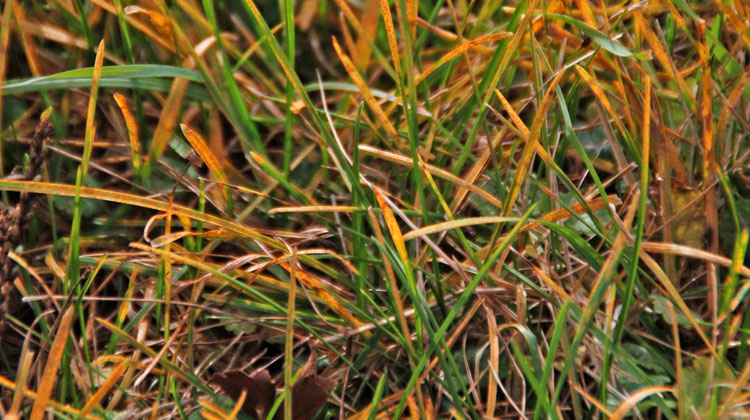HOW TO IDENTIFY COMMON FUNGAL LAWN DISEASES
In order for fungal diseases to strike, three factors must be in play: disease pathogens, weather conditions that favor disease development, and susceptible lawn grasses. Without all three factors present, grasses keep the upper hand. While you can’t control the weather, you can recognize fungal threats, learn how to identify lawn and grass diseases, and take action.
Active fungal disease usually occurs in times of stress, which vary according to grass growing regions. For example, warm- season grasses are hit when abnormally cool temperatures slow their growth; cool- season grasses are most vulnerable under warmer than normal conditions. Excessive rain, drought and overcast skies all impact your lawn’s ability to fight back.
You can identify the following common fungal lawn and grass diseases for warm- and cool-season grasses with the lawn and grass disease tips that follow:

RED THREAD
Red thread is a turf-grass disease that is commonly caused by low levels of nitrogen in your soil or environmental stress. Red thread is a growth of the fungus Laetisaria fuciformis. When it appears, you will notice, red thread-like branches, sometimes compared to antlers. The grass is usually tan or light brown beneath the red thread growths.
FAIRY RING
Fairy Ring is caused by a fungus found in soils called basidiomycetes and may affects many lawns. Your fairy ring may appear in the form of dark green grass growing in a circular pattern, mushrooms may also grow as a result of this fungal growth and are a clear indicator of the fairy ring fungus on your property.


BROWN PATCH
Brown Patch lawn disease is a common fungus that can infect a variety of common turf-grasses and cause brown patches on your lawn. These Brown Patch thrives when the weather is hot and humidity is high during the summer months.
If you are seeing spotting on your leaf blades—which may eventually bleed together to turn the entire leaf brown— it is safe to suspect that Brown Patch is invading your lawn.
DOLLAR SPOT
Dollar spot, a lawn disease that affects a wide range of turf-grasses throughout the majority of the year, is a particularly subtle lawn fungus that can make your beloved turf have unsightly patches throughout.
As brown patch progresses through your lawn, areas may bleed into each other to form large, irregular discolored spots that can become several feet in diameter. Each affected leaf blade will show a distinct pattern of straw-colored, tan bands often with reddish-brown margins above and below each band.


GRAY LEAF SPOT
If your lawn has suddenly lost its vibrancy, it’s likely because your turf is under attack by a fungal disease. Among the many lawn diseases that homeowners should be aware of is gray leaf spot (Pyricularia grisea). This condition is known for the oblong spots it creates on the leaves of grass.
If you suspect gray leaf spot you will need to examine your blades for oval spots that appears on the surface of a grass blade. This spot is typically tan in color with a dark brown border.
When these spots are exposed to high humidity or wet conditions, the oblong leaf spots will become gray and fuzzy with increased sporulation growth. This disease will soon expand across the entire grass leaf, resulting in lawn death.
GRASS RUST
Grass rust is a common visitor to lawns beginning in August and continuing through the fall months. Grass rust gives your lawn a yellowish-orange to reddish-brown appearance. A bad case of it can make your entire lawn look off-color. Look closely and you’ll see tiny pustules on individual grass leaves.


PYTHIUM
Pythium is a common mold found in the soil that causes many different turfgrass diseases. Pythium blight, on the other hand, occurs when the pathogen attacks the turfgrass tissue. However, when the roots and crowns are affected, the disease is called Pythium root rot.
SNOW MOLD
Living in Utah you may experience this problem with your lawn from time to time in the spring as patches of discolored grass, either straw-colored or matted with a white or pinkish web-like coating start to appear in early spring. As the snow cover begins to melt you may notice snow mold and it may continue to thrive and spread as long as the weather is cool and damp. There is good news! These discolored spots may begin to shrink as the weather becomes hot and dry, but in rare years that are cool and wet, the spots may contiune through the summer and into the fall.
